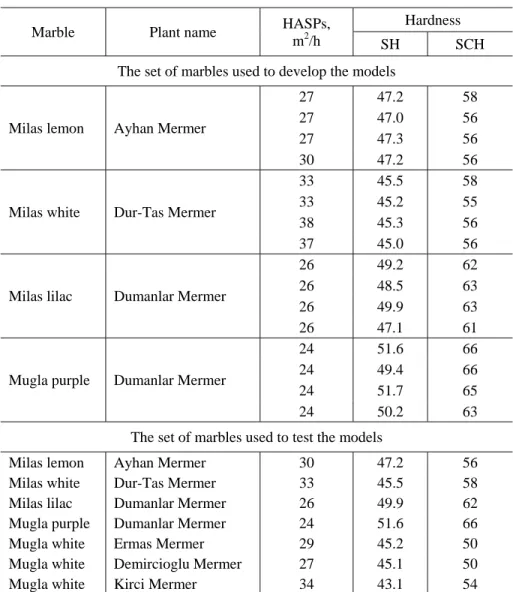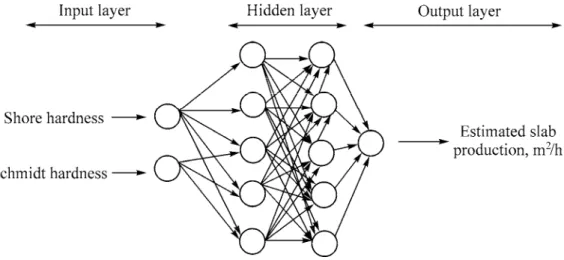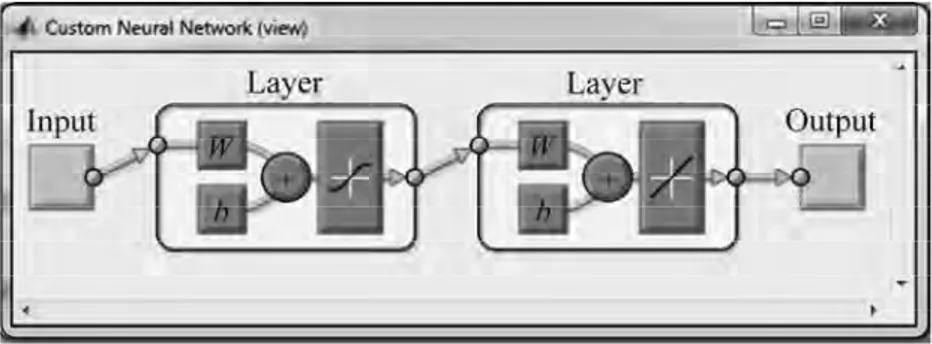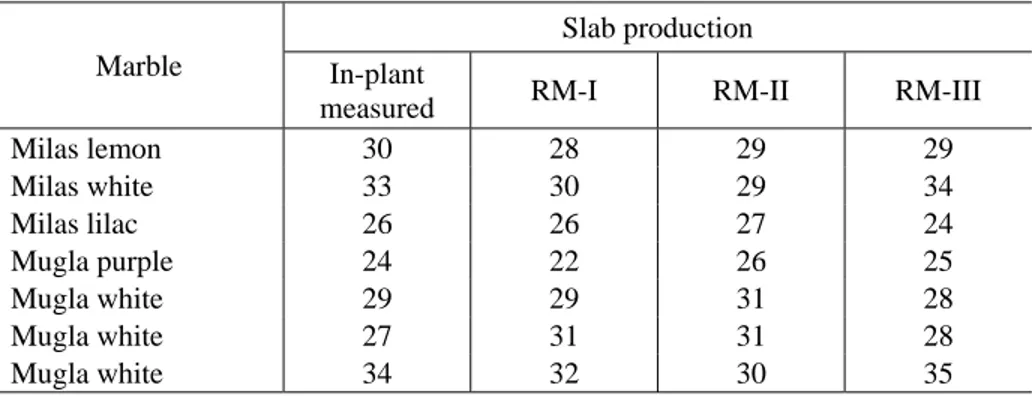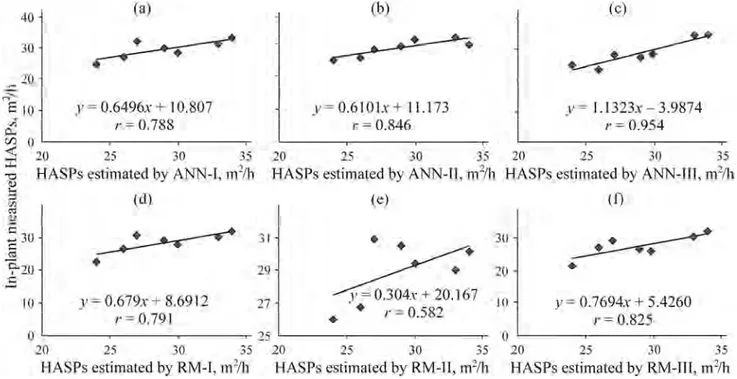_______________________________ SCIENCE OF MINING ____________________________
____________________________________________________________________________________________________________________________ _________________________________________________________________________________________________________________
MACHINES
Performance Prediction of Circular Diamond Saws
by Artificial Neural Networks and Regression Method Based
on Surface Hardness Values of Mugla Marbles, Turkey
A. Guneya*a
Mugla Sıtkı Kocman University, Department of Mining Engineering, Mugla, Turkey *e-mail: aguney@mu.edu.tr
Received January 2, 2018 Revised November 20, 2019 Accepted November 27, 2019
Abstract—Sawing of natural stones with diamond-impregnated circular saws is extensively implemented in stone processing plants in variety of applications that include sawing, cutting, splitting and trimming. Hence, the cost of diamond saws and energy have become important input in terms of estimating the hourly areal slab productions (HASPs) from the standpoint of effective cost analyses, feasible and sustainable designing of stone processing plants prior to reaching a decision for the investment. This study aimed at estimating the HASPs of the machines with circular diamond saws during the dimensioning of marble blocks quarried in Mugla (Turkey) Region. Thus, the models were generated to estimate the HASPs by artificial neural networks (ANN) and regression method (RM), based on Shore and Schmidt hardness values of rocks. Also, HASPs were acquired through in-plant measurements in order to justify the HASPs estimated by ANN and RM models. The analyses of the models generated using ANN proved to yield very strong consistencies with HASPs measured in the plants. Hence, the HASPs can be estimated reliably by the ANN models which also may be considered as a tool in designing of natural stone processing plants based on rock surface hardness.
Keywords: Shore hardness (SH), Schmidt hardness (SCH), hourly areal slab productions (HASPs), artificial neural network (ANN), regression method (RM).
DOI: 10.1134/S1062739119066356
INTRODUCTION
Turkey which has a significant share in world natural stone market, has recently reinforced its rank economically in terms of reserves, production and export. Quarried blocks of marbles are carried into the marble processing plants in order to be processed and offered to the market as semi-finished or finished products. 85% of Turkey’s export of natural stones is composed of semi-processed or processed products. Circular saws with diamond-impregnated tools are extensively used in marble processing plants to dimension the natural stones. Sawing constitutes a significant part of the cost in marble processing in which energy consumption and the diamond saws are known as the most significant ones.
In literature, numerous studies have been conducted to establish relationships between the cost of energy. In [1], the researchers carried out cutting experiments on seven different marble types and calculated cutting forces and specific energy values according to the data obtained from the experiments. Following the determination of physical and mineralogical characteristics of the marbles used in the experiments the author revealed an empirical approach by using multiple RM to determine the cutting force and specific energy (SE) values based on rock characteristics. [8] presented models of both ANN and RM, based on the data of porosity, internal friction angle and cohesion to predict the slab production of circular diamond saws. They stated that ANNs yielded better results in the prediction slab production. In [15], they carried out cutting experiments using 2 different diamond
saws of different diameters and diamond sockets manufactured to different diamond concentrations, with no changes in dimensions and matrix of the sockets. The study reported a decrease in diamond wearing as the cutting depth and the diamond concentration increased. Using 15 different rocks, the effect of fracture toughness and rock brittleness on specific energy of the rocks during the cutting process with circular saws was analyzed [4]. The models were developed based on simple and multiple regression and fuzzy logic to estimate the specific energy from rock properties. In [5], they carried out cutting experiments at constant cutting parameters on four different marble types of magmatic origin to calculate the specific cutting energy for each marble type. Following the analyses of the effect of physical and mechanical rock properties on cutting energy by regression they stated that rock porosity, a physical property, and rock uniaxial compressive strength, a mechanical property, played important roles on cutting energy. In [6], the authors attempted to predict the influence of marble cutting parameters on energy consumption by ANNs and ANFIS. They used rock hardness, peripheral saw speed and cut advance speed as input and specific cutting energy as output. They concluded that predicted results were quite close to that obtained by experimental work. In [7] cutting experiments with circular saws on Afyon White marble to investigate the relationships of the noise level with various peripheral saw speeds and advance rates were conducted. They found that the noise level was directly related to cutting forces, unit wear and unit energy.
In a study conducted by [8], in-plant cutting experiments by circular diamond saws on Mugla marbles were performed to investigate the influence of grain size of minerals on the HASP, based on experimentally obtained Shore and Schmidt hardness values. The experiments were conducted using laboratory marble saw machine on Usak green marble to model the cutting duration by ANNs as taking the cut advance speed, rpm of the circular saws and cutting depth as input and cutting end time as output [9]. When the data were introduced in the model, predicted cutting duration came very close to measured cutting duration. In [10] the researchers attempted to predict the specific energy of carbonate rocks in industrial stones cutting process and found that high correlations exist between SE and uniaxial compressive strength. Certain models of regression and ANN were developed and tested, and then compared by using a test data set which was not used during the construction of models [11]. The results of their work revealed that both modeling approaches are capable of giving adequate prediction for the SE with an acceptable accuracy level. Moreover, ANN model was found more reliable than RM for the prediction of the SE. Knowledge of HASPs of marble cutting equipment is of great importance for the investors who have to make a decision prior to investing capital on establishing a marble processing plant. This study was conducted to estimate the HASPs of marble sawing machines assembled in marble processing plants with circular diamond saws in Mugla Province.
1. LABORATORY AND FIELD MEASUREMENTS
In this study, the marbles known by the trade names as Mugla white, Milas lemon, lilac and purple were used. The list that includes the names and locations of the plants and quarries is given in Table 1.
Table 1. List of the rocks studied by their trade names and locations
Marble Plant name Quarry location
Milas lemon Ayhan Mermer, Yatagan Kestaneci village Milas white Dur-Tas Mermer, Yatagan Milas
Milas lilac Dumanlar Mermer, Bayir Kestaneci village Mugla purple Dumanlar Mermer, Bayir Kestaneci village Mugla white Ermas Mermer, Yatagan Yatagan
Mugla white Demircioglu Mermer, Yatagan Bayir
Averaged values of certain physical and mechanical properties of the marbles from Table 1:
Specific weight, kN/m3 27.30
Water absorption by volume, % 0.07
Porosity, % 0.25
Ultrasonic velocity, m/s 5.10
Uniaxial compressive strength, MPa 82.71 Brazilian tensile strength, MPa 5.17
Point load strength, MPa 3.55
3-point bending strength, MPa 14.90 Böhme abrasion strength, cm3/50 cm2 23.00
Shore (SH) and Schmidt (SCH) hardness values were determined experimentally in the laboratory and the HASPs were acquired by on-site measurements in marble processing plants. Sixteen of the collecteddatawere used in order to generate the ANN and RM models (Table 2) [8]. Three different ANN- and RM-models were developed based on SH, SCH and aggregate SH-SCH of rocks, as shown in Table 2.
Table 2. Experimental data
Marble Plant name HASPs,
m2/h
Hardness
SH SCH The set of marbles used to develop the models
Milas lemon Ayhan Mermer
27 47.2 58 27 47.0 56 27 47.3 56 30 47.2 56
Milas white Dur-Tas Mermer
33 45.5 58 33 45.2 55 38 45.3 56 37 45.0 56
Milas lilac Dumanlar Mermer
26 49.2 62 26 48.5 63 26 49.9 63 26 47.1 61
Mugla purple Dumanlar Mermer
24 51.6 66 24 49.4 66 24 51.7 65 24 50.2 63 The set of marbles used to test the models
Milas lemon Ayhan Mermer 30 47.2 56
Milas white Dur-Tas Mermer 33 45.5 58
Milas lilac Dumanlar Mermer 26 49.9 62 Mugla purple Dumanlar Mermer 24 51.6 66
Mugla white Ermas Mermer 29 45.2 50
Mugla white Demircioglu Mermer 27 45.1 50
Mugla white Kirci Mermer 34 43.1 54
2. ARTIFICIAL NEURAL NETWORKS (ANN)
Artificial neural networks (ANN) are known as logical software developed to perform basic functions of human being by imitating the working mechanism of the brain such as the ability to derive new information by learning, recalling and making generalizations. Today, artificial neural networks (ANN) are used in different disciplines such as physics, mathematics, electronics and computer engineering and in their respective applications. Practical use of ANN is usually based on quick classification of the systems in various forms and structures, estimation and control of the data. In fact, the most important reason for widespread use of ANN in engineering applications is to bring solutions to difficult problems that cannot be easily solved by conventional methods. Instead of using mathematical models to solve scientific and engineering problems, ANNs use simulations which are based on observation or the data obtained from the experiments [12].
In the presented work, a Multi-Layer Perception (MLP) type of ANNs has been used for prediction of HASPs. A MLP network is the most commonly employed ANN architecture. A typical MLP structure is shown in Fig. 1, in which three types of layers exist: the input, output and the hidden layers. Each neuron on the input layer is assigned to an attribute in data and produces an output which is equal to the scaled value of the corresponding attribute. The hidden layers, usually numbering one or two, are intermediate between the input and output layers [13].
The interconnection between the i-th and j-th layers is labelled as wij; these being called weights.
It is the study of these interconnections between layers that provide a powerful tool for prediction and classification. During the learning phase, the interconnections are optimized in order to minimize a predefined function [14]. Weighted sum of the input to a neuron is computed, and the output of a neuron and the activation of the neuron are determined by an activation function. For a MLP, training procedure is a very important to complete a required task. Training of a MLP means to determine the best weights of connections between the neurons in order to obtain minimum difference between actual and predicted value of dependent variable. Back propagation is a most extensively utilized training algorithm. On the other hand, certain parameters such as number of input neurons, hidden neurons, output neurons, and activation function influence the performance of ANNs. In a prediction problem based on cause and effect relationship, the number of input neurons is equal to the number of independent variables, and the number of output neurons is equal to the number of dependent variables.
Fig. 1. The MLP structure of ANN. Input layer
Shore hardness
Schmidt hardness
-Hidden layer Output layer
Estimated slab production, m2/h
Table 3. Structures of ANN models
Model Neuron number Activation function Learning function
Performance function
input hidden output first second
ANN-I
1 5 1
Purelin Tangend sigmoid
Trainlm Square Error (MSE)
ANN-II Tangend sigmoid Tangend sigmoid
ANN-III Tangend sigmoid Purelin
3. GENERATION OF ANN MODELS TO ESTIMATE THE HASPs
In this study, ANN models were generated by Neural Network (nntool) in MATLAB R2009 software. ANN modeling was carried out in 3 different models [15]. In the first model the SH, in the second model the SCH and in the third model aggregate SH- SCH values were input. HASPs were the only output parameter for all models generated. Many different network architectures of ANN were tested in the estimation of HASPs. The algorithm of feed forward–back propagation was used since it was widely employed in engineering applications. The network architectures which yielded the best results were defined as the models ANN-I, ANN-II and ANN-III (Table 3). The configuration of ANN-III model generated in MATLAB 2009 is given in Fig. 2.
All the models (ANN-I, II, III and RM-I, II, III ) generated in this work were used to estimate the HASPs of block cutting machines with circular diamond saws based on experimentally determined SH, SCH and aggregated SH-SCH. In-plant measured HASPs and the HASPs estimated by ANN-I, II and III models are presented in Table 4.
4. REGRESSION METHOD (RM)
Regression method (RM) was performed for the prediction of HASPs as one of the most conventional statistical methods and for offering an indirect estimation by empirical equations. RM is extensively used for modelling and analyzing the experimental results. RM focuses on learning more about the relationship between several predict or variables and a dependent. The performance of the model depends on a large number of factors that act and interact in a complex manner. In this study, RM was conducted using SPSS 17 software in order to estimate the HASPs for block marble cutting machines in plants. The input data for model developing given in Table 2 were used in ANN training, were also used to create the models of RM, where as the values in Table 2 for testing the models were used as the test data only. Regression analyses of SH and SCH were conducted separately in the estimation of HASPs however, multi-regression analysis were also carried out to consider both hardnesses (SH, SCH) to estimate the HASPs (Table 5). The comparison between in-plant measured HASPs and the HASPs estimated by RM-I, RM-II and RM-III models are displayed in Table 6.
Table 4. In-plant measured HASPs vs. the HASPs estimated by the ANN models, m2/h Marble Slab production In-plant measured Estimated ANN-I Estimated ANN-II Estimated ANN-III Milas lemon 30 29 31 29 Milas white 33 31 32 34 Milas lilac 26 27 26 24 Mugla purple 24 25 25 25 Mugla white 29 30 29 28 Mugla white 27 32 28 28 Mugla white 34 33 30 35
Table 5. Relationships used to develop RM-I, II and III models
Model HASP, m2/h r t F
RM-I 83.665–1.186SH 0.71 7.756 25.984
RM-II 50.317–0.380SCH 0.48 6.425 7.641
RM-III 94.525+0.402SCH–1.914SH 0.75 8.109 16.308
5. STATISTICAL EVALUATIONS OF MEASURED AND ESTIMATED DATA OF HASPS
Meaningful findings were obtained in result of the works conducted to establish the relationships between in-plant measured and estimated HASPs by ANN-I, II, III and RM-I, II, III models, which were run on separate input of SH, SCH and aggregate of SH-SCH.
The relationships between in-plant measured HASPs and the HASPs estimated by the models ANN-I and RM-I are illustrated in Fig. 3a, b, d, e, respectively, in which SH alone was defined as input and estimated HASPs as output parameters. Correlation coefficients of the relationships between in-plant measured HASPs and the HASPs estimated by ANN-I and RM-I models were found to be 0.788 and 0.791, respectively, which demonstrates a strong consistency ratio (87%) (Fig. 4a). Correlation coefficients between in-plant measured HASPs and the HASPs estimated by ANN-II and RM-II models were found to be 0.785 and 0.582, respectively. Hence, a strong consistency ratio of 87% can be seen between in-plant measured HASPs and the HASPs estimated by the model ANN-II. However, a medium consistency ratio of 57% was obtained by RM-II model, based only on SCH values (Fig. 4c).
Table 6. Comparison between in-plant measured HASPs and the HASPs estimated by RM-I, II and III models, m2/h
Marble
Slab production In-plant
measured RM-I RM-II RM-III
Milas lemon 30 28 29 29 Milas white 33 30 29 34 Milas lilac 26 26 27 24 Mugla purple 24 22 26 25 Mugla white 29 29 31 28 Mugla white 27 31 31 28 Mugla white 34 32 30 35
Fig. 3. Relationship between in-plant measured HASPs and the HASPs estimated by (a) ANN-I, (b) ANN-II, (c)
ANN-III models and (d) RM-I, (e) RM-II, (f) RM-III models.
The relationships between in-plant measured HASPs and the HASPs estimated by the models ANN-III and RM-III are given in Figs. 3c and 3f, respectively, in which the aggregate SH-SCH values were set as input and estimated HASPs as output parameters. Correlation coefficients of the relationships between in-plant measured HASPs and the HASPs estimated by ANN-III and RM-III models were found to be 0.954 and 0.825, respectively. Hence, as shown in Fig. 4b, a strong consistency ratio of 87% was established between in-plant measured HASPs and the HASPs estimated by the model ANN-III, based on the aggregate SH-SCH values. However, RM-III model yielded a very poor consistency (14%) between in-plant measured HASPs and the HASPs estimated by RM-III model, based on the input of aggregate SH-SCH values (Fig. 4d).
Fig. 4. Comparative analysis of the (1) measured in-plant HASPs and (2) and the HASPs estimated by (2) ANN-I,
(3) RM-I models, based on (a) SH values, (4) ANN-II, (5) RM-II models, based on (c) SCH values, and (6) ANN-III, (7) RM-III models, based on (b, d) SH-SCH values.
40 30 10 ~ EI() .;. 0... (a) ,I'= 0.6496x + I 0.807 r = 0.788 VJ O ' - - - - ~ - - ~ - - - - , - ,
ii
20 ::!.5 30 35 -o HA Ps estimated by ANN-I, m1lh ~ ~ (tll 11 E ~ 3U ~ ~20~
•
C: 10 y=0,679x+ 8.6912 1·=0.791 31 29 27 (b) y=0.6101x+ 11.173 r= 0.846 (c) y= l.1323x-3.9874 r = 0.954 20 25 30 35 20 25 30 35HA Ps estimated by ANN-II, m2/h HA Ps estimated by ANN-III, m~/h
00 (0 • • 3U
~
~ 1 'W•
JO y = 0. 7694.r + 5.4260•
· • r - 0.581 r=0.825 0 1- ~ - - ~ - - ~ - - - ~ 0 ~ - - ~ - - ~ - -- ~ 20 25 JO 35 20 25 JO 35~IASPs estimated by RM-I, m% HASPS l:Stimated by RM-11, m2/h
40 (a) JO -o • 20 c.: .:a-3 "' E -o , 10 V v, :.... 0... ~ Cl'J 0 ~ ;S (c) ,.. ....; 40 4 C: "O - ' C....,. V "' "' 'O
c.
E.., I • -C: ... ~ 2U 5 ICI 0 2 3 4 5 6 7 I 1 3Sample number
20 25 JO 35
HASPs estimated by RM-Ill, mJ/h
(b)
r,
y
(d)
CONCLUSIONS
The HASPs estimated by ANN and RM models based on SH values appeared to be more consistent with a high consistency ratio of 87% when compared to the HASPs obtained by in-plant measurements, which suggests that SH be a reliable input parameter for both ANNs and RM models. Similarly, the HASPs estimated by ANN model based on SCH values also seemed to be reliable with a high consistency ratio of 87% when compared to the HASPs measured in the plants. However, the RM model yielded a medium consistency with a ratio of 57% based on the same input parameter. Hence, It may be suggested that SCH values be reliable input parameter for the ANN model in estimating HASPs nevertheless, not reliable input for the RM models. The use of aggregate SC-SCH values as input yielded a high consistency ratio of 87% for the ANN model. However, a very low consistency ratio of 14% was obtained for the RM model, in other words, SH-SCH aggregate may not be suggested as input in estimating the HASPs by RM models.
SH, SCH and aggregate SH-SCH values can be suggested and reliably used as input parameter in ANN models, since the HASPs can be estimated with strong consistency ratios of 87%. As the number of input parameters and the amount of data are increased, it is expected that more confident estimations of HASPs with high consistency ratios will be obtained for the models to be generated.
REFERENCES
1. Büyüksağış, İ.S., Sawability Analysis of Marbles in Circular Daimond Block Cutting Machines, Osmangazi University Graduate School, PhD Thesis, Turkey, 1998.
2. Kahraman, S., Altun, H., Tezekici, B.S., and Fener, M., Sawability Prediction of Carbonate Rocks From Strength Parameters Using Artifical Neural Networks, Int. J. Rock Mech. & Min. Sci., 2006, vol. 43, pp. 157–164. 3. Özçelik, Y., Ünver, B., and Bayram, F., Sawability Classification of Some Natural Stones with Circular
Sawing and Numerical Modeling of Sawing Mechanism, TÜBİTAK, 2008.
4. Şengün, N., Influence of Fracture Toughness and Brittlenes on Cutting Efficiency of Circular Diamond Saws, Suleyman Demirel University, PhD Thesis, 2009, Isparta, Turkey.
5. Şengün, N., Altındağ, R., and Koçcaz, C.E., The Sawability Analysis of Some Magmatic Rocks Found in Isparta Region, J. Sci. and Eng. of Dokuz Eylul University, 2009, vol. 11, no. 31, pp. 22–31.
6. Caner, M. and Akarslan, E., Estimation of Specific Energy Factor in Marble Cutting Process Using ANFIS and ANN, J. Eng. Sci. of Pamukkale University, 2009, vol. 15, no. 2, pp. 233–239.
7. Bayram, A., Yaşıtlı, N.E., and Özçelik, Y., The Relations Between Noise Level and Cutting Parameters in Circular Diamond Sawing, The 22nd Int. Min. Congr. of Turkey Proc. Book, 2011, pp. 407–413.
8. Guney, A., Performance Prediction of Large-Diameter Circular Saws Based on Surface Hardness Tests for Mugla (Turkey) Marbles, J. Rock Mech. Rock Eng., 2011, vol. 44, pp. 357–366.
9. Güvenç, U., Dursun, M., and Çimen, H., Artificial Neural Network Based Modelling of Cutting Time in Marble Cutting Process, SDU Int. Tech. Sci., 2011, vol. 3, pp. 9–16.
10. Sengun, N. and Altindag, R., Prediction of Specific Energy of Carbonate Rock in Industrial Stones Cutting Process, Arab. J. Geosciences, 2013, vol. 6, no. 4, pp. 1183–1190.
11. Aydin, G., Karakurt, İ., and Hamzacebi, C., Performance Prediction of Diamond Sawblades Using Artificial Neural Network and Regression Analysis, Arab. J. Sci. and Eng., 2015.
12. İnan, A., Usage Areas of Artificial Neural Networks in Power Systems, J. Kaynak Electicial, 1999, vol. 119, pp. 104–114.
13. Rumelhart, D.E., Hinton, G.E., and Williams, R.J., Learning Internal Representation by Error Propagation. in: Parallel and Distributed Processing: Explorations in the Microstructure of Cognition, Foundations, MIT Press: Cambridge, MA, 1986, Vol. 1.
14. Pontes, F.J., Ferreira, R.J., Silva, B.M., Paiva, P.A., and Balestrassi, P.P., Artificial Neural Networks for Machining Processes Surface Roughness Modeling, Int. J. Adv. Manuf. Tech., 2010, vol. 49, pp. 879–902. 15. Taşdemir, Ş., The Comparative Study to Determine Surface Roughness with Artificial Neural Network

